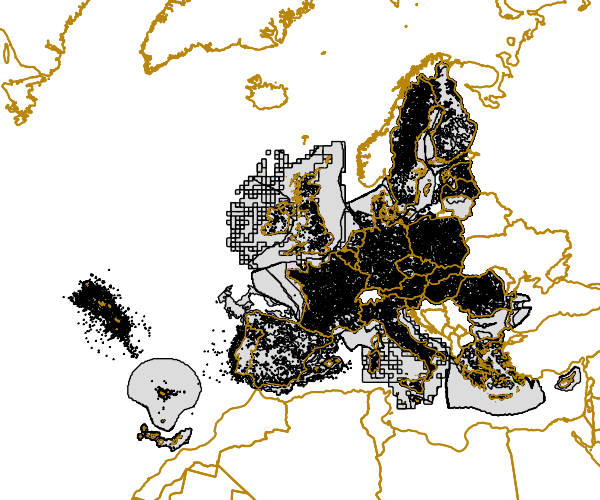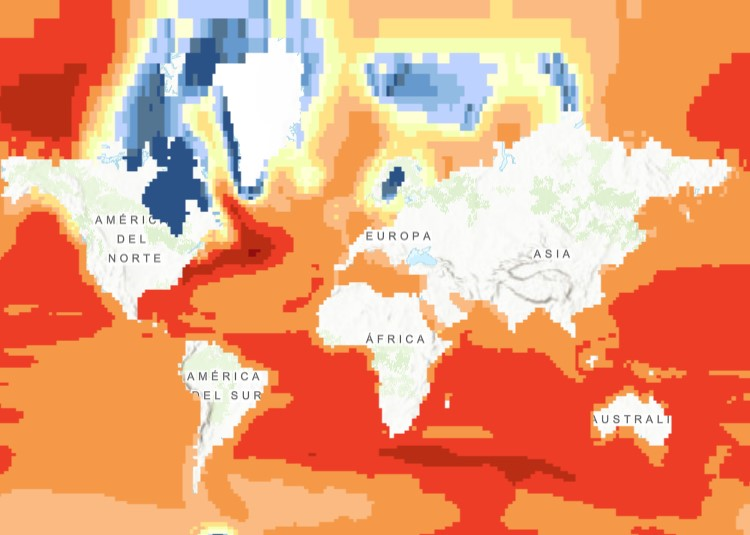2014
Type of resources
Available actions
Topics
INSPIRE themes
Keywords
Contact for the resource
Provided by
Years
Formats
Representation types
Update frequencies
status
Scale
Resolution
-

Gridded Distribution of Species as reported during the Article 17 of the Habitats Directive (92/43/EEC) covering the period 2007 to 2012. The data covers the EU 27 (2007). All Member States are requested by the Habitats Directive (92/43/EEC) to monitor habitat types and species considered to be of Community interest. Article 17 of the Habitats Directive 92/43/EEC requires that every 6 years Member States prepare reports to be sent to the European Commission on the implementation of the Directive. The Article 17 report for the period 2007-2012 includes assessments on the conservation status of the habitat types and species of Community interest. This version does not include species flagged as sensitive by Member States. Information on the data quality of the 2007-2012 reporting round is available at http://bd.eionet.europa.eu/article17.
-

Gridded Distribution of Species as reported during the Article 17 of the Habitats Directive (92/43/EEC) covering the period 2007 to 2012. The data covers the EU 27 (2007). All Member States are requested by the Habitats Directive (92/43/EEC) to monitor habitat types and species considered to be of Community interest. Article 17 of the Habitats Directive 92/43/EEC requires that every 6 years Member States prepare reports to be sent to the European Commission on the implementation of the Directive. The Article 17 report for the period 2007-2012 includes assessments on the conservation status of the habitat types and species of Community interest. This version does not include species flagged as sensitive by Member States. Information on the data quality of the 2007-2012 reporting round is available at http://bd.eionet.europa.eu/article17. The data are available in the table ART17_SD_without_sensitive of the database.
-

CLC00_revised is one of the datasets produced within the frame the Corine Land Cover programme referring to revision of land cover / land use status of year 2000. With the help of CLC data it is possible to provide support for protecting ecosystems, halting the loss of biological diversity, tracking the impacts of climate change, assessing developments in agriculture and implementing the EU Water Framework Directive. CLC data is an important data set for the implementation of key priority areas of the Sixth Environment Action Programme of the European Community. CLC data can show, for instance, where fragmentation of the landscape by roads and other infrastructure is worsening and thus increasing the risk that ecosystems can no longer connect with each other, putting the survival of their flora and fauna in danger. In the agricultural field CLC data can highlight where major structural changes are continuing or intensifying, such as the conversion of pasture to arable land, expansion or reduction in the area of fallow land and land taken out of production ('set aside'), or the abandonment of farming altogether. CLC serve as input to the EC 'Inspire' (INfrastructure for SPatial InfoRmation in Europe - http://inspire.jrc.it) initiative. This initiative intends to trigger the creation of a European spatial information infrastructure that delivers to the users integrated spatial information services. CLC programme is also a contribution to the Global Monitoring for Environment and Security (GMES http://gmes.info) initiative, run by the European Commission and the European Space Agency, to provide environmental information from a combination of air- and space-based observation systems and in-situ monitoring.
-

With the help of CLC data it is possible to provide support for protecting ecosystems, halting the loss of biological diversity, tracking the impacts of climate change, assessing developments in agriculture and implementing the EU Water Framework Directive. CLC data is an important data set for the implementation of key priority areas of the Sixth Environment Action Programme of the European Community. CLC data can show, for instance, where fragmentation of the landscape by roads and other infrastructure is worsening and thus increasing the risk that ecosystems can no longer connect with each other, putting the survival of their flora and fauna in danger. In the agricultural field CLC data can highlight where major structural changes are continuing or intensifying, such as the conversion of pasture to arable land, expansion or reduction in the area of fallow land and land taken out of production ('set aside'), or the abandonment of farming altogether. CLC serve as input to the EC 'Inspire' (INfrastructure for SPatial InfoRmation in Europe - http://inspire.jrc.it) initiative. This initiative intends to trigger the creation of a European spatial information infrastructure that delivers to the users integrated spatial information services. CLC programme is also a contribution to the Global Monitoring for Environment and Security (GMES http://gmes.info) initiative, run by the European Commission and the European Space Agency, to provide environmental information from a combination of air- and space-based observation systems and in-situ monitoring.
-

CLC00_revised is one of the datasets produced within the frame the Corine Land Cover programme referring to revision of land cover / land use status of year 2000. With the help of CLC data it is possible to provide support for protecting ecosystems, halting the loss of biological diversity, tracking the impacts of climate change, assessing developments in agriculture and implementing the EU Water Framework Directive. CLC data is an important data set for the implementation of key priority areas of the Sixth Environment Action Programme of the European Community. CLC data can show, for instance, where fragmentation of the landscape by roads and other infrastructure is worsening and thus increasing the risk that ecosystems can no longer connect with each other, putting the survival of their flora and fauna in danger. In the agricultural field CLC data can highlight where major structural changes are continuing or intensifying, such as the conversion of pasture to arable land, expansion or reduction in the area of fallow land and land taken out of production ('set aside'), or the abandonment of farming altogether. CLC serve as input to the EC 'Inspire' (INfrastructure for SPatial InfoRmation in Europe - http://inspire.jrc.it) initiative. This initiative intends to trigger the creation of a European spatial information infrastructure that delivers to the users integrated spatial information services. CLC programme is also a contribution to the Global Monitoring for Environment and Security (GMES http://gmes.info) initiative, run by the European Commission and the European Space Agency, to provide environmental information from a combination of air- and space-based observation systems and in-situ monitoring.
-

The Common Database on Designated Areas (CDDA) is more commonly known as Nationally designated areas. The inventory began in 1995 under the CORINE programme of the European Commission. It is now one of the agreed Eionet priority data flows maintained by EEA with support from the European Topic Centre on Biological Diversity. It is a result of an annual data flow through Eionet countries. The EEA publishes the data set and makes it available to the World Database of Protected Areas (WDPA). The CDDA data can also be queried online in the European Nature Information System (EUNIS). Geographical coverage of GIS vector boundary data: Albania, Austria, Belgium, Bosnia and Herzegovina, Bulgaria, Croatia, Cyprus, Czech Republic, Denmark, Estonia, Finland, Great Britain, Greece, Ireland, France, Germany, Iceland, Italy, Kosovo under UNSC Resolution 1244/99, Latvia, Liechtenstein, Lithuania, the North Macedonia, the Netherlands, Norway, Poland, Portugal, Romania, Serbia, Slovakia, Slovenia, Spain, Sweden and Switzerland. EEA does not have permission to distribute some or all sites reported by Austria, Bulgaria, Estonia, Ireland, Romania and Turkey. When re-using the data, copyright is to be mentioned specifically for Estonia and for Finland: "Estonian Environmental Register 02.03.2015"; "©Finnish Environment Institute, 2015".
-

With the help of CLC data it is possible to provide support for protecting ecosystems, halting the loss of biological diversity, tracking the impacts of climate change, assessing developments in agriculture and implementing the EU Water Framework Directive. CLC data is an important data set for the implementation of key priority areas of the Sixth Environment Action Programme of the European Community. CLC data can show, for instance, where fragmentation of the landscape by roads and other infrastructure is worsening and thus increasing the risk that ecosystems can no longer connect with each other, putting the survival of their flora and fauna in danger. In the agricultural field CLC data can highlight where major structural changes are continuing or intensifying, such as the conversion of pasture to arable land, expansion or reduction in the area of fallow land and land taken out of production ('set aside'), or the abandonment of farming altogether. CLC serve as input to the EC 'Inspire' (INfrastructure for SPatial InfoRmation in Europe - http://inspire.jrc.it) initiative. This initiative intends to trigger the creation of a European spatial information infrastructure that delivers to the users integrated spatial information services. CLC programme is also a contribution to the Global Monitoring for Environment and Security (GMES http://gmes.info) initiative, run by the European Commission and the European Space Agency, to provide environmental information from a combination of air- and space-based observation systems and in-situ monitoring.
-

The raster dataset (1ºx1º) shows the projected change in relative sea level (in metres) in 2081-2100 compared to 1986-2005 for the medium-low emission scenario RCP4.5, based on an ensemble of Coupled Model Intercomparison Project Phase 5 (CMIP5) climate models. Projections consider land movement due to glacial isostatic adjustment but not land subsidence due to human activities. No projections are available for the Black Sea. The dataset has been used as a source for an earlier version of the EEA indicator “Global and European Sea Level”: https://www.eea.europa.eu/data-and-maps/indicators/sea-level-rise-5/assessment.
-

This gridded dataset presents the projected changes (in percentage) in heavy precipitation in winter season (December, January, February) in Europe, from 1971-2000 to 2071–2100 for the Representative Concentration Pathways (RCP) 8.5 scenario, based on the ensemble mean of different Regional Climate Models (RCMs) nested in different General Circulation Models (GCMs). This dataset is an output of the EURO-CORDEX data, produced in the context of the EURO-CORDEX initiative. EURO-CORDEX is the European branch of the CORDEX initiative, producing ensemble climate simulations based on multiple dynamical and empirical-statistical downscaling models forced by multiple global climate models from the Coupled Model Intercomparison Project Phase 5 (CMIP5). More information about this initiative on: https://www.euro-cordex.net/060374/index.php.en. The dataset has been used in the EEA Indicator "Heavy precipitation in Europe": https://www.eea.europa.eu/data-and-maps/indicators/precipitation-extremes-in-europe-3/assessment, which in the meantime has been updated.
-

With the help of CLC data it is possible to provide support for protecting ecosystems, halting the loss of biological diversity, tracking the impacts of climate change, assessing developments in agriculture and implementing the EU Water Framework Directive. CLC data is an important data set for the implementation of key priority areas of the Sixth Environment Action Programme of the European Community. CLC data can show, for instance, where fragmentation of the landscape by roads and other infrastructure is worsening and thus increasing the risk that ecosystems can no longer connect with each other, putting the survival of their flora and fauna in danger. In the agricultural field CLC data can highlight where major structural changes are continuing or intensifying, such as the conversion of pasture to arable land, expansion or reduction in the area of fallow land and land taken out of production ('set aside'), or the abandonment of farming altogether. CLC serve as input to the EC 'Inspire' (INfrastructure for SPatial InfoRmation in Europe - http://inspire.jrc.it) initiative. This initiative intends to trigger the creation of a European spatial information infrastructure that delivers to the users integrated spatial information services. CLC programme is also a contribution to the Global Monitoring for Environment and Security (GMES http://gmes.info) initiative, run by the European Commission and the European Space Agency, to provide environmental information from a combination of air- and space-based observation systems and in-situ monitoring.
 RUC Geo-Data catalogue
RUC Geo-Data catalogue